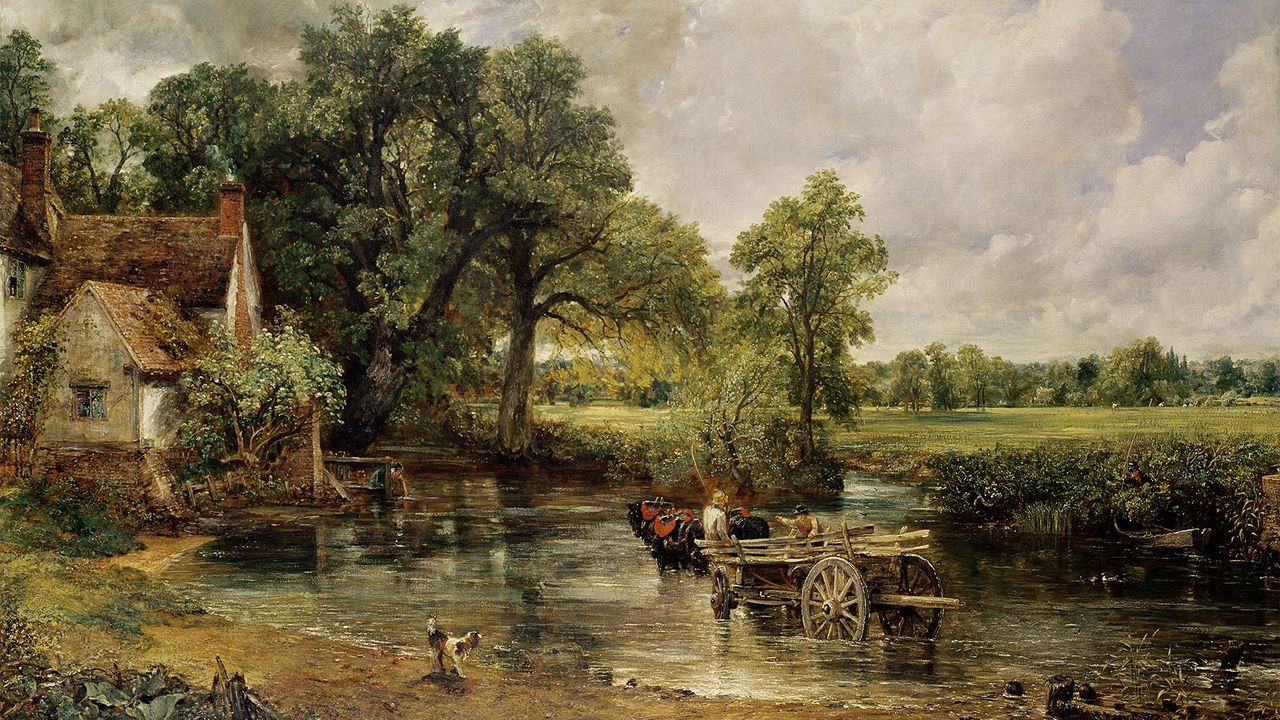
Robert Draws – The Hay Wain, painted by John Constable in 1821, remains one of the most iconic works in British art history. This masterpiece captures the essence of rural life in England during the early 19th century. Known for its vivid portrayal of the natural landscape, The Hay Wain invites viewers into a peaceful and idyllic scene of the English countryside. The painting is famous for its realism and romanticized view of nature. Its combination of detailed brushwork and vibrant colors makes it a beloved piece.
In The Hay Wain, Constable paints a rural scene set on a riverbank in Suffolk, England. The central focus of the painting is a cart, or “wain,” pulled by three horses, transporting hay. The cart crosses a serene river, while a figure walks alongside the horses. In the background, lush green fields and a large oak tree dominate the landscape. The sky is filled with soft clouds, creating a tranquil atmosphere. The painting emphasizes harmony between humans, animals, and nature.
Constable’s decision to depict a simple rural activity, such as hay harvesting, highlights the deep connection between people and the land. His skillful use of light and shadow further enhances the natural beauty of the scene. The landscape comes alive with the gentle flow of the river, the rustling of the trees, and the vibrant greenery. The Hay Wain captures a moment of stillness, yet it conveys the timeless cycle of nature.
The Hay Wain is often associated with the Romantic movement in art, which celebrated emotion, nature, and the sublime. Romantic artists sought to convey the beauty and power of nature, often emphasizing the relationship between humanity and the natural world. In this painting, Constable uses the landscape to express feelings of nostalgia and reverence for rural life.
The work highlights the peaceful, pastoral existence that was increasingly disappearing due to industrialization. By focusing on this traditional scene, Constable romanticizes a simpler, more harmonious way of life. The lush landscape is portrayed as an unspoiled paradise, untouched by the hardships of modern development. Through his careful attention to detail, Constable invites the viewer to reflect on the beauty of the world around them.
The Hay Wain remains an important part of both British art history and the Romantic movement. It has influenced generations of artists, particularly those who sought to capture the beauty of the natural world. Many art critics often hail the painting for its innovative technique and composition. Constable’s skill in rendering the landscape stands out, particularly his ability to depict subtle changes in light and atmosphere.
Over the years, The Hay Wain has been exhibited in numerous galleries worldwide. It now resides in the collection of the National Gallery in London. Its lasting appeal clearly arises from its universal themes of nature, beauty, and tranquility. Additionally, the work continues to resonate with modern audiences, offering a glimpse into a world that seems both timeless and fleeting.
John Constable’s technique in The Hay Wain is a key factor in its enduring popularity. He used oil paints to create rich, textured surfaces that gave depth and dimension to the landscape. His application of thick, textured brushstrokes is evident in the depiction of the foliage, sky, and water. This technique helped convey the dynamic qualities of nature, bringing the scene to life.
Constable was known for his use of natural light, and this is clearly evident in The Hay Wain. The play of light and shadow on the trees and river creates a sense of depth and realism. His careful study of atmospheric effects allowed him to capture the nuances of weather, seasons, and time of day. The result is a painting that feels alive with movement, despite the stillness of the scene.
“Read more: Whistler’s Mother: The Story Behind the Masterpiece”
The Hay Wain also serves as a symbol of English identity. The rural landscape depicted in the painting is often seen as an idealized version of England’s countryside. At the time Constable painted this work, the country was undergoing significant social and economic changes, particularly with the rise of industrialization. Many people were leaving rural areas to work in factories, and traditional ways of life were fading.
By painting such a scene, Constable offered a vision of rural life that spoke to the collective memory of English heritage. The Hay Wain became a representation of the beauty and tranquility of rural England, a place many people longed for during a time of rapid industrial growth. As such, the painting captures the essence of the English countryside and the nostalgia that people felt for it.
The Hay Wain stands as one of the most celebrated works of art in history. Through his masterful technique and deep connection to the natural world, John Constable created a timeless depiction of the English countryside. The painting’s romanticism and attention to detail invite viewers to pause and reflect on the beauty of nature. Even today, The Hay Wain continues to inspire admiration, serving as a powerful reminder of the harmonious relationship between humanity and the world around us.